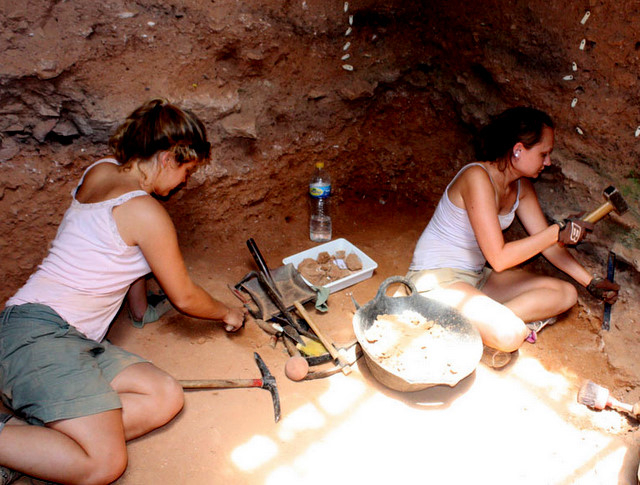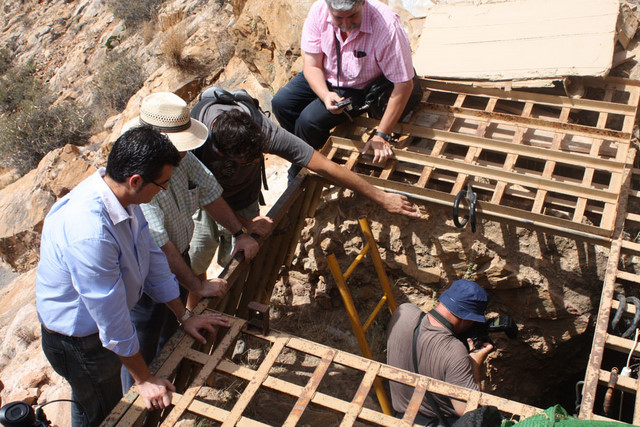Date Published: 08/08/2010
La Sima de las Palomas, Neanderthal remains
Remains in the Sima de las Palomas in Torre Pacheco date from 150,000-300,000 years ago
 Each summer, archaeology students from across the world partake in the summer excavation camps operating throughout the Region of Murcia, continuing work on several of the important archaeological sites which exist within the Region .
Each summer, archaeology students from across the world partake in the summer excavation camps operating throughout the Region of Murcia, continuing work on several of the important archaeological sites which exist within the Region .
The Sima de las Palomas, in Los Dolores de Pacheco, part of the municipality of Torre Pacheco, held its annual open day yesterday for members of the public to visit the excavation site and today presented the finds from this current summersexcavation camp.
This particular site is the most important Neanderthal site in the Mediterranean arc, having now yielded remains from eight different individuals, in the form of 120 different pieces of bone and teeth and other items which would have been used in the daily lives of the inhabitants of this cave..
During the summer the excavations have been focusing on extraction of remains of 3 individuals, 2 adults and one younger individual, believed to have been buried in some sort of landslide.
 Archaeologists are unable to tell whether the individuals were alive when buried, or whether they had been lain in this position after death, but the quantity of material found on this site indicates that it was used by a number of individuals over a long period of time.
Archaeologists are unable to tell whether the individuals were alive when buried, or whether they had been lain in this position after death, but the quantity of material found on this site indicates that it was used by a number of individuals over a long period of time.
The site at the moment appears quite low down within the rock face, but at the time it was inhabited would have been a lot more open and easily accessible. Over the years the internal space was literally filled with silt, conserving the remains and bones buried within, and whilst this created conditions which preserved the bones, it makes extraction of the remains a slow and painstaking process as the now solid silt is carefully chipped away bit by bit.
Volunteers spend most of their summer working in cramped conditions on their knees, but the site provides an invaluable opportunity for archaeology students to gain field experience and learn more about their chosen area of study.
Plans are for the finds to be displayed in a new museum of Paleontology, which will bring together remains from other prehistoric sites across the Region.
 In the meantime, anyone interested in archaeology or in learning more about the archaeological sites within the region, may enjoy visiting the archaeological museum in Murcia.
In the meantime, anyone interested in archaeology or in learning more about the archaeological sites within the region, may enjoy visiting the archaeological museum in Murcia.
There is an excellent display there which shows the development of what is now, essentially, us, together with a well constructed map charting the development of other species, such as the Neanderthals, who inhabited this area before we came along.
Neanderthals evolved in Europe and were here up until around 30,000 years ago, although the individuals found in the Sima de las Palomas site are believed to have belonged to a period known as the Pleistocene Superior, which dates them somewhere between 150,000 and 300,000 years old.
They became extinct when Homo sapiens moved across from Africa 30,000 years ago and were considerably more intelligent and dexterous than urban legend would have us believe. Youll be surprised at the sophistication and quality of the flint tools they made and used if ever you get the chance to visit the archaeological museum, and the quality of the flints found on this site clearly shows the ability to manipulate flint and use tools in various ways.
Click for Archaeology Museum, Murcia
article_detail




 Each summer, archaeology students from across the world partake in the summer excavation camps operating throughout the Region of Murcia, continuing work on several of the important archaeological sites which exist within the Region .
Each summer, archaeology students from across the world partake in the summer excavation camps operating throughout the Region of Murcia, continuing work on several of the important archaeological sites which exist within the Region . Archaeologists are unable to tell whether the individuals were alive when buried, or whether they had been lain in this position after death, but the quantity of material found on this site indicates that it was used by a number of individuals over a long period of time.
Archaeologists are unable to tell whether the individuals were alive when buried, or whether they had been lain in this position after death, but the quantity of material found on this site indicates that it was used by a number of individuals over a long period of time. In the meantime, anyone interested in archaeology or in learning more about the archaeological sites within the region, may enjoy visiting the archaeological museum in Murcia.
In the meantime, anyone interested in archaeology or in learning more about the archaeological sites within the region, may enjoy visiting the archaeological museum in Murcia.

